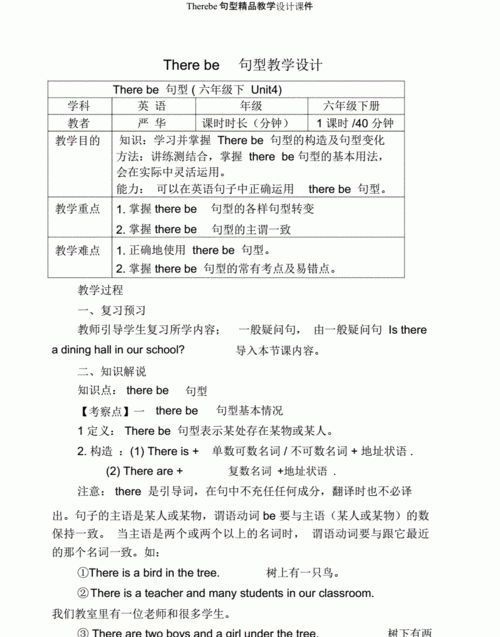本文目录
初中英语there be句型教案
初中英语there be句型语法
There be 的句子结构

There be是一个"存在"句型,表示"有"的意思,
肯定句的形式为:There be + 名词(单数或复数)+地点状语或时间状语。
be动词单复数的确定,看be后边第一个名词,当所接主语为单数或不可数名词时,be动词形式为is;当所接主语为复数名词时,be动词为are;当be动词后接两个以上主语时,be动词与最临近主语保持数上的一致。意思为"某地有某人或某物"。如:
There is an eraser and two pens on the desk. 桌子上有一块橡皮和两支钢笔。
There are two pens and an eraser on the desk. 桌上有两支钢笔和一块橡皮。
(1)there be的否定句,即在be的后面加上not。
否定形式为:There be + not + (any) + 名词+地点状语。
There is not any cat in the room. 房间里没猫。
There aren't any books on the desk. 桌子上没书。
(2)there be句型的疑问句就是将be提到句首:Be there + (any) +名词+地点状语
肯定回答:Yes, there is / are. 否定回答:No, there isn't / aren't.
-Is there a dog in the picture?画上有一只狗吗
-Yes, there is. 有。
-Are there any boats in the river?河里有船吗
-No, there aren't. 没有。
(3)特殊疑问句:How many . . . are there (+地点状语)
某地有多少人或物回答用There be . . .
There's one. / There are two / three / some . . .
有时直接就用数字来回答。One. / Two . . .
-How many students are there in the classroom?教室里有多少学生
-There's only one. / There are nine. 只有一个。/有九个。
(4)如果名词是不可数名词,用:How much + 不可数名词 + is there + 地点状语
How much water is there in the cup?杯中有多少水
How much food is there in the bowl?碗里有多少食物
我们经常会听到老师在课堂上提到关于there be句型,那么对此不懂得可不要错过了对there be的学习哦!
初中英语语法大全:动词的种类
关于英语中动词的种类知识,希望同学们很好的掌握下面的内容学习。
动词的种类
动词是表示动作或状态的词,按其词义和在句子中的作用可分为行为动词,连系动词,助动词和情态动词。
1.行为动词
行为动词可分为及物动词 (vt)和不及物动词(vi),及物动词表示动作或状态,有完整的词义,能单独作谓语,后跟宾语;不及物动词表示动作或状态,有完整的词义,能单独作谓语,但后面不能直接跟宾语,如要带宾语则与介词或副词构成短语。
如:
More and more people study English.(vt)
The students are listening to the teacher carefully.(vi)
2.连系动词
连系动词本身有一定的词义,但不能独立作谓语,必须与表语一起构成谓语。常用的`连系动词有 be, get, turn, become, look, feel, grow, seem, sound, taste, smell等。
如:
Our country is becoming stronger and stronger.
It feels damp.
3.助动词
助动词本身无词义,不能单独作谓语,只能和主要动词一起构成谓语动词,表示否定,疑问及动词的时态、语态、人称和数等语法特征,助动词有 be,do,have,shall,will等。
如:
How do you usually come to school?
The children are playing yo-yo now.
4.情态动词
情态动词本身有一定的意义,但不能独立作谓语,只能和主要动词原形一起构成谓语,表示说话人的语气和情态。情态动词没有人称和数的变化。情态动词有 can (could),may(might),must, need, ought to, dare等。
如:
Can I help you?
- Must we go now? -No, you needn't .
a. can与be able to的用法有所区别。can只用于一般现在时和过去时,指本身有能力的"能";be able to用于各种时态均可,指须经过努力而"能"。
b. must与have/has to的用法。must表示说话人主观认为"必须",只用于一般现在时和一般将来时;have/has to表示客观需要,意为"不得不",它可用于各种时态。
c.need和dare既可作情态动词也可作行为动词。
以上对动词的种类知识的内容讲解学习,相信同学们已经能很好的掌握了吧,希望同学们在考试中取得很好的成绩。
初中英语语法大全:动词不定式的形式
对于英语的学习中,关于动词不定式的形式知识点的内容,我们做下面的讲解学习哦。
动词不定式的形式
1.作主语。 如:
To learn English is very important.
但实际上不定式作主语常用 it来作形式主语,而将不定式移至谓语动词后作真正的主语。
如上句可表达为:
It's very important to learn English.
2.作表语。 如:
My idea is to ring him up at once.
3.作宾语。 如:
I have decided to go to Binjiang Primary School.
4.作宾语补足语。
a. ask, want, teach, tell, know, would like, allow等动词后面接动词不定式作宾语补足语。
如: The policemen asked him to get off the bus.
b. hear, see, look at, feel, watch, notice, listen to等动词后接不带to的动词不定式作宾语补足语。
如: We often see Miss Li clean the classroom.
c. let, make, have这些使役动词后接不带to的动词不定式作宾语补足语。但在被动语态中这些不带to的都须带上to。
如: In those days the bosses often made the workers work day and night.
d.动词help接动词不定式作宾语补足语,可带to也可不带to。
如: Can you help me (to) carry the heavy bag?
5.作定语。
a.与被修饰词有动宾关系。如:I have something important to tell you.但如果不定式动词为不及物动词,后面的介词千万不要省略。
如: Maybe they have three rooms to live in.
b.与被修饰词有主谓关系。
如: Mr Liang is always the first to come and the last to leave.
c.与被修饰之间只有修饰关系。
如: I have no time to play cards.
6.作状语,表示目的、原因、方法、方向、结果等。
如: I'll go to meet my friend at the railway station.
7.不定式复合结构"for sb. to do sth" 作主语时,常用"It is +adj+ for
of sb. to do sth"的句式。形容词good, bad, polite, unkind, kind, ice, clever,
right, wrong, careful等用"It is +adj +of sb. to do sth."
其他形容词用 for。
如:
It's dangerous for you to ride so fast.
It's very kind of you to help me.
8.动词不定式与疑问句who, what, which, when, how, where, whether等连用。
如: I don't know when to start.
He didn't tell me where to go.
但上面结构相当于一个从句,故上述句子也可表达为:
I don't know when we'll start.
He didn't tell me where he would go.
注意:
a.有些动词或动词短语不能带不定式,只能接动词的-ing形式。
如: enjoy, finish, keep, mind, miss(错过),be busy, go on, keep on, be worth, practise等。
如: The peasants are busy picking apples.
Would you mind my opening the door?
b.有些动词后可接不定式,也可接动词的-ing形式,但意思不同。
如: Lu Jian forgot to post the letter.(该寄但还没做)
Lu Jian forgot posting the letter.(已经寄过信了)
They stopped to sing a song.(停止在做的工作而去做另一件工作)
They stopped singing.(停止正在做的工作)
希望上面对动词不定式的形式知识的内容讲解学习,同学们都能很好的掌握,相信同学们会取得很好的成绩的哦。
初中英语语法大全:短语动词的四种类型
同学们认真学习,下面是老师对短语动词的四种类型知识总结。
短语动词的四种类型
动词与介词、副词等构成的固定短语,叫短语动词。主要有四类:
一、动词+副词
有的一般不跟宾语,如go ahead, fall behind, get up, lie down, go up, run out, give in, stay up等;有的可以跟宾语,如put out, carry out, give up, wake up, check in, eat up, fill in, find out, fix up, hand in, mix up, look up, make out, turn down, work out等。
注意:宾语是名词时,放在副词前面或后面都可以,但若作宾语的是人称代词时,就只能放在动词和副词之间了。如:
We’ve decided to put the meeting off (=put off the meeting) . 我们决定把会议推迟。
We’ve decided to put it off. 我们决定将它推迟。(不说put off it)
二、动词+介词
如ask for, care for, call for, break into, deal with, call on, look for等。后面必须接宾语。如:
I don’t care for tea. 我不喜欢喝茶。
三、动词+副词+介词
如look forward to, put up with, looked up to, go in for, go along with, date back to, look down on, keep up with, add up to, run out of等。如:
She soon caught up with us. 她很快赶上了我们。
四、动词+名词+介词
如take care of, pay attention to, make use of, make contribution to做出贡献等。如:
Take care of your brother while I am away. 我不在的时候,你要照顾好你弟弟。
希望上面老师对短语动词的四种类型知识的讲解学习,同学们都能很好的掌握,相信同学们会学习的很好的哦。
初中英语语法大全:及物动词与不及物动词
关于英语中及物动词与不及物动词的知识学习,我们做下面的内容讲解。
及物动词与不及物动词
根据其后是否带宾语,动词可分为及物动词(带宾语)和不及物动词(不带宾语)。如:
When will he arrive? 他什么时候到?(arrive 不带宾语,为不及物动词)
He reached Beijing yesterday. 他昨天到达北京。(reach 带了宾语,为及物动词)
有的动词既可用作及物动词也可用作不及物动词:
The child is playing. 这小孩在玩。(不及物用法)
The child is playing the piano. 这小孩在弹钢琴。(及物用法)
He is writing. 他在写字。(不及物用法)
He is writing a letter. 他在写信。(及物用法)
The boy is reading. 这男孩在阅读。 (不及物用法)
The boy is reading a magazine. 这男孩在看杂志。(及物用法)
上面对及物动词与不及物动词知识的内容讲解学习,希望给同学们的学习很好的帮助,相信同学们会学习的更好的吧。
初中英语语法大全:实义动词与非实义动词
下面是对英语中实义动词与非实义动词知识的内容讲解,希望同学们很好的掌握。
实义动词与非实义动词
根据其含义和句子功用,动词可分为实义动词和非实义动词(包括时态助动词和情态助动词等)。如:
He bought a story book. 他买了一本故事书。(buy 为实义动词)
He has read the story book. 他已读过这本故事书。(has 为时态助动词,read为实意动词)
He should read the story book. 他应该读读这本故事书。(should 为情态助动词,red为实义动词)
上面对实义动词与非实义动词知识的内容讲解学习,相信同学们已经能很好的掌握了吧,希望同学们考试成功。
;there be句型的肯定句否定句和一般疑问句
1、肯定句:There is / are
2、否定句:There isn't / aren't
3、一般疑问句:Are / Is there
there be
读音:英 [ðeə(r) bi] 美 [ðer bi]
释义:存在句型。
例句:
It's a very tricky problem, but I think there are a number of things you can do.
那是个非常棘手的问题,但我想有几样事你是可以做到的。

扩展资料
there be的定义:There be 句型是英语中常用句型, 意思是“有”,表示“人或事物的存在”或“某地有某物”。There在此结构中是引导词,已经没有副词“那里”的含义。
用法:
1、There be后面的名词是句子的主语,属倒装结构。
2、疑问句形式是将be或will/have/can/must等助动词、情态动词提至there之前,否定形式则直接在be或助动词、情态动词后加not,因此要表达“某个地方或某个时间存在什么事物或人”的时候常用“There be+名词+地点(时间)这一句型。
3、There be 句型中的be应和其后出现的主语在数上一致,即“就近原则”。
4、如果主语是复数名词,却表示一笔金额或一个总数或表达一个单个概念时,则仍用单数be形式。
5、There be 中的be有时可以是lie,stand,used to be,seem to be,appear to be 等。
6、There is(was)+no +动词ing结构相当于It is(was) impossible to +动词原形。
there be句型的特殊疑问句
There be句型的否定式的构成和含有be动词的其它句型一样,在be后加上not或no即可.注意not和no的不同:not是副词,no为形容词,not a/an/any + n.相当于no+ n.
例句:
There aren't any pictures on the wall.
2.There isn't a bike behind the tree.
3.There will be no one at home tomorrow morning.
4.There aren't any flowers.
5.There is no bike behind the tree.
There be 句型的一般疑问句是将be 放在there 之前,回答时用yes或no,后接简单答语。句式:Be(Is/Are)+there+某物/某人+地点/时间?
例句:
Is there a cake on the table?
2.Will there be a party tonight?
3.Have there been any letters from your mother lately?
4.Are there any fish in the water?
5.Is there any water on Mars?
There be 句型是英语中常用句型, 意思是"有",表示"人或事物的存在"或"某地有某物"。There在此结构中是引导词,已经没有副词"那里"的含义。
There be 后面的名词是句子的主语,属倒装结构。其问句形式是将be或will/have/can/must等助动词、情态动词提至there之前,否定形式则直接在be或助动词、情态动词后加not,因此要表达“某个地方或某个时间存在什么事物或人”的时候常用“There be + 名词+ 地点(时间)这一句型。
There be句型的特殊疑问句形式有以下三种变化:
① 对主语提问:当主语是人时,用"Who's+介词短语?";当主语是物时,用"What's + 介词短语?"。
注意:无论原句的主语是单数还是复数,对之提问时一般都用be的单数形式(回答时却要根据实际情况来决定)。如:
There are many things over there. →What's over there?
There is a little girl in the room.→Who is in the room?
② 对地点状语提问:提问地点当然用"Where is / are+主语?"啦!例如:
There is a computer on the desk. → Where is the computer?
There are four children on the playground. →Where are the four children?
there be对数量提问:一般有两种句型结构:
How many+复数名词+are there+介词短语?
How much+不可数名词+is there+介词短语?

there be结构变否定句
答:there be not“没有”
只要涉及到句子的肯否疑,一定和be动词,助动词,和情态动词有关。
否定句:be+not
助动词+not
情态动词+not

以上就是关于there be否定句型教学设计 ,初中英语there be句型教案的全部内容,以及there be否定句型教学设计 的相关内容,希望能够帮到您。

